New Hall teacup, Neoclassical cobalt blue and gilt patt. 555, ca 1810
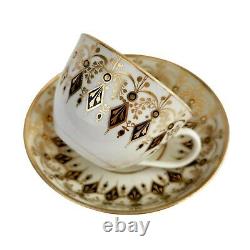

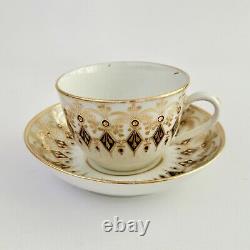
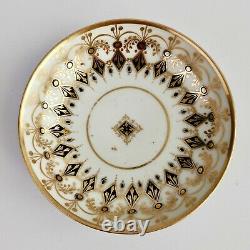
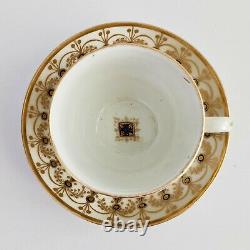
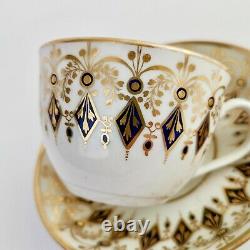
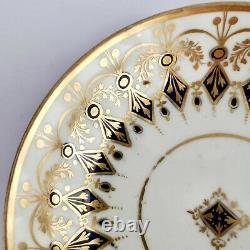
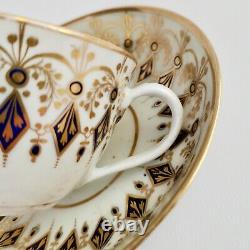
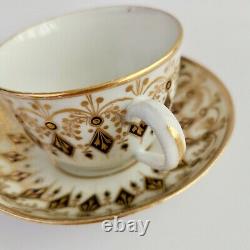
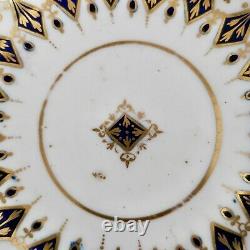
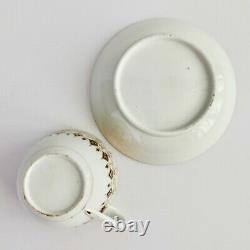


This is beautiful teacup and saucer made by New Hall around the year 1810. The set is in decorated in the sophisticated Neoclassical style of the Regency era.
We also have an entire tea service in the same pattern available, please see separate listing. The New Hall factory started as a cooperative of several Staffordshire potters making use of the porcelain license of Bristol Porcelain Company after this went in demise. It quickly grew out to be a leading porcelain maker, and the first to make true porcelain in Staffordshire.
New Hall is mostly known for its huge output of its typical "hybrid hard paste" porcelain, as New Hall had adapted the original hard paste recipe from Bristol in order to save on production costs - a frugal Staffordshire improvement on the first hard paste porcelain recipes, which were quite difficult and expensive to produce. Once Josiah Spode had standardised bone china this quickly became the standard. New Hall was late to take up bone china but after 1814 they made it their main output, and they made some very high quality items. This set is made in this typical "hybrid hard paste" porcelain, as New Hall had adapted the original hard paste recipe from Bristol (formerly Plymouth), but adapted it slightly in order to save on production costs.
You can tell this by the way the porcelain is less milky than bone china. As this hybrid porcelain was slightly cheaper to make and very popular among customers who were used to the more stony Chinese Export porcelain, New Hall was a late adapter of bone china, which was already used by most other factories around the time this set was made.
The decoration on this set is pattern 555, which consists of deep cobalt blue bands decorated with very elegant abstract Regency-type patterns in gilt. CONDITION REPORT The set is in excellent antique condition without any damage, repairs or crazing, just some wear as visible in the pictures.There are some production imperfections in the glaze. Antique British porcelain is never perfect.
Kilns were fired on coal in the 1800s, and this meant that china from that period can have some firing specks from flying particles. British makers were also known for their experimentation, and sometimes this resulted in technically imperfect results. Due to the shrinkage in the kiln, items can have small firing lines or develop crazing over time, which should not be seen as damage but as an imperfection of the maker's recipes, probably unknown at the time of making. Items have often been used for many years and can have normal signs of wear, and gilt can have signs of slight disintegration even if never handled. I will reflect any damage, repairs, obvious stress marks, crazing or heavy wear in the item description but some minor scratches, nicks, stains and gilt disintegration can be normal for vintage items and need to be taken into account.There is widespread confusion on the internet about the difference between chips and nicks, or hairlines and cracks. I will reflect any damage as truthfully as I can, i. A nick is a tiny bit of damage smaller than 1mm and a chip is something you can easily see with the eye; a glazing line is a break in the glazing only; hairline is extremely tight and/or superficial and not picked up by the finger; and a crack is obvious both to the eye and the finger.
Etcetera - I try to be as accurate as I can and please feel free to ask questions or request more detailed pictures! DIMENSIONS teacup 8.5cm (3.5") diameter; saucer 13.3cm (5.25"). This item is in the category "Pottery & Glass\Cookware, Dinnerware & Serveware\Cup & Saucers".
The seller is "rattlethecups" and is located in this country: GB. This item can be shipped worldwide.
- Handmade: Yes
- Colour: Gold
- Country/Region of Manufacture: United Kingdom
- Use: Tableware
- Original/Reproduction: Antique Original
- Style: NeoClassical
- Year of Production: ca 1810
- Material: Bone China, Ceramic, Porcelain
- Theme: Neoclassical
- Pattern: Neoclassical
- Type: Cup & Saucer
- Features: Date-Lined
- Year Manufactured: 1810
- Number of Items in Set: Two-Piece
- Origin: English
- Set Includes: teacup, Saucer
- Brand: New Hall
- Original/Licensed Reproduction: Original
- Time Period Manufactured: Pre-c.1840
- Sub-Type: British
- Manufacturer/ Type: New Hall


